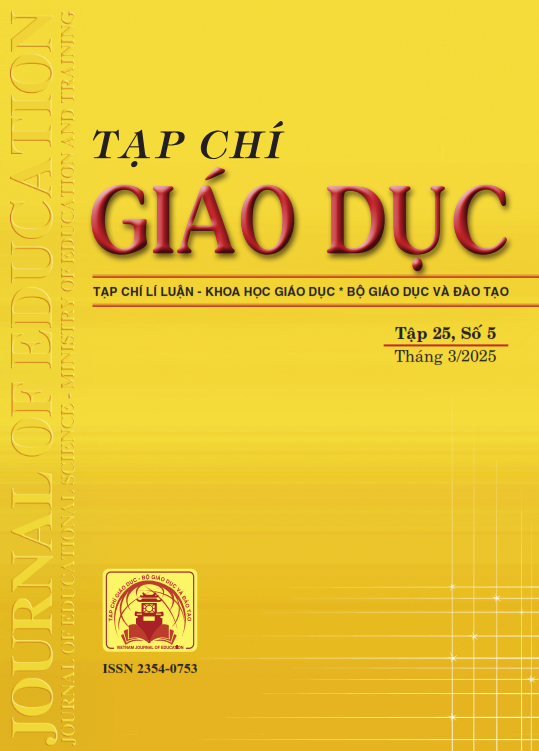Bồi dưỡng tư duy đại số trong dạy học bài toán thực tiễn chủ đề “Hàm số y=ax^2 (a≠0) và phương trình bậc hai một ẩn” (Toán 9)
Tóm tắt
Algebraic thinking is constituted from generalizations or the representation of generalizations, as well as activities guided by symbols within the standardized symbol systems. This type of thinking involves studying structures and systems abstracted from calculations and relationships, exploring functions, relations, and related variations, as well as utilizing a set of modeling languages (both within and beyond mathematics). The goal of this paper is to discuss algebraic thinking in teaching practical problems on the topic of the function y=ax^2 (a≠0) and quadratic equations with one variable, aiming to improve learning outcomes in these topics. The study employs theoretical research methods to fulfil the objectives. The new contribution of the article is the identification of algebraic thinking components, a proposed teaching process and methods for organizing instruction to promote algebraic thinking when teaching practical problems related to the function y=ax^2 (a≠0) and quadratic equations with one variable. This paper serves as a valuable reference for educational researchers as well as teachers seeking to foster teaching effectiveness.
Tài liệu tham khảo
Chu Cẩm Thơ (2018). Phát triển tư duy thông qua dạy học môn Toán ở trường phổ thông. NXB Đại học Sư phạm.
Edtech Leaders Online (2007). Three Components of Algebraic Thinking: Generalization, Equality, Unknown Quantities. Algebraic Thinking in Elementary School. http://www.edtechlearders.org
Hodgen, J., Oldenburg, R., & Strømskag, H. (2018). Algebraic thinking. Developing Research in Mathematics Education, 32-45. https://doi.org/10.4324/9781315113562-4
Kaput, J. J., Carraher, D. W., & Blanton, M. L. (2008). Algebra in the Early Grades. Routledge.
Kieran, C. (2004). Algebraic Thinking in the Early Grades : What Is It? Mathematics Educator, 8(1), 139-151.
Kriegler, S. (2004). Just what is algebraic thinking? Mathematics Educator, 8(1), 139-151.
Leder, G. (2006). Psychology of Mathematics Education at ICME 9. Proceedings of the Ninth International Congress on Mathematical Education, 382-383. https://doi.org/10.1007/1-4020-7910-9_99
Lins, R. C., & Bell, A. (1992). A framework for understanding what algebraic thinking is. PhD Thesis. University of Nottingham.
Maudy, S. Y., S, D., & M, E. (2018). Student’ Algebraic Thinking Level. International Journal of Information and Education Technology, 8(9), 672-676. https://doi.org/10.18178/ijiet.2018.8.9.1120
Nguyễn Hữu Nhanh Tiến, Nguyễn Thị Duyến (2019). Quan sát tư duy Đại số của học sinh từ góc nhìn của giáo viên Toán tương lai. Tạp chí Khoa học và Giáo dục, Trường Đại học Sư phạm - Đại học Huế, 02(50), 48-59.
Odondi, A., & Aje, C. T. (2025). Leveraging Algebraic Thinking in STEM Education to Equip the Next Generation of Problem Solvers. Retrieved from https://docs.lib.purdue.edu/instemed/2025/briefs/8/
Radford, L. (2000). Signs and meanings in students’ emergent algebraic thinking: A semiotic analysis. Educational Studies in Mathematics, 42, 237-268. https://doi.org/10.1023/A:1017530828058
Radford, L. (2008). Iconicity and contraction: A semiotic investigation of forms of algebraic generalizations of patterns in different contexts. ZDM - International Journal on Mathematics Education, 40(1), 83-96. https://doi.org/10.1007/s11858-007-0061-0
Sibgatullin, I. R., Korzhuev, A. V., Khairullina, E. R., Sadykova, A. R., Baturina, R. V., & Chauzova, V. (2022). A Systematic Review on Algebraic Thinking in Education. Eurasia Journal of Mathematics, Science and Technology Education, 18(1), 1-15. https://doi.org/10.29333/EJMSTE/11486
Trần Nam Dũng, Trần Đức Huyên, Nguyễn Thành Anh, Nguyễn Văn Hiển, Ngô Hoàng Long, Nguyễn Đặng Trí Tín (2024). Toán 9 (Sách giáo viên, bộ Chân trời sáng tạo). NXB Giáo dục Việt Nam.
Windsor, W. (2010). Algebraic Thinking : A Problem Solving Approach. Proceedings of the 33rd Annual Conference of the Mathematics Education Research Group of Australasia, 33, 665-672.
Zazkis, R., & Liljedahl, P. (2002). Generalization of patterns: The tension between aegebraic thinking and aegebraic notation. Educational Studies in Mathematics, 49(3), 361-378. https://doi.org/10.1023/A:1020291317178
Tải xuống
Đã Xuất bản
Cách trích dẫn
Số
Chuyên mục
Giấy phép

Tác phẩm này được cấp phép theo Ghi nhận tác giả của Creative Commons Giấy phép quốc tế 4.0 .












